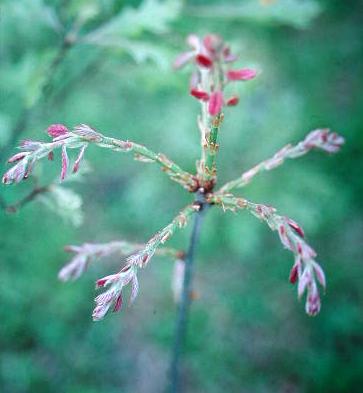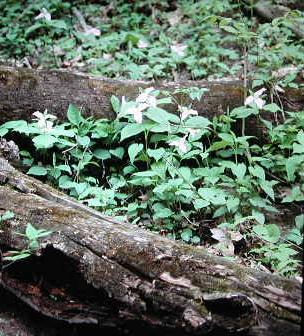| April
“Sweet April showers do spring May flowers.”
-- Thomas Tusser (1524 –1580)
Since at least as early as the 16th century it has been no secret that
“April showers bring May flowers.” I will go the pundits one better on
that score--even two better, or more.
Surely! In my book, April showers do trigger an explosion of wildflowers
that literally paints forest floors and meadows with bright hues. It is,
indeed, another gift of the Magi.
But April showers also trigger an explosion of fungi that has been set
on “touch” throughout the waning days of winter, not to mention high water
which translates into some unusual, but often quite productive, fishing
opportunity.
Before advancing my thinking on the latter two points, I probably should
point out that I would go to the woods in April to enjoy Mother Nature’s
flower basket even if The Creator had not thought up spring morels and
the piscatorial set.
Wildflowers--from the inconspicuous harbinger of spring (a k a salt
and pepper, Erigenia bulbosa), one of our earliest showoffs, to
the varied members of the trillium family (and at many stops between) are
a huge magnet that tugs incessantly at me in April.
Yes, the wildflowers would be quite enough for me, and they don’t confine
themselves to terra firma. Some of our most beautiful spring flowers will
be found on trees and shrubs without mentioning spectacular displays by
redbud, dogwood and some of the others that scream to be noticed.
Take, for example, the wooly-worm-like flowers of the many hickory species
found in Hoosierland, or the leaves of some of the oaks in their early
stages of life . . . or even the reddish-pink flowers of the maples . .
. Beauty beyond comparison . . . and there is no end to the parade for
those who open their eyes to April.

|
 |
| The trout lily offers beauty
in April, but it also speaks volumes about spring morels. |
As leaves of this pin oak
seedling unfold, their subdued pink and gray hues are surpassed in beauty
only by the symmetrical design of the branches. |
[Click on photo to view
larger image.]
Now, let’s deal with those morels,
which occupy most outdoor minds in Indiana at this time of year, and that
high-water fishing.
This page already is loaded with information on finding, cooking and
preserving morels (just do a search
on mushrooms).
But I probably should point out that it already is later than usual
for the earliest of the morel species--the little waxy caps, a small version
of the semilibera species that have a stem connecting above the
outer perimeter of the cap.
The wildflowers come into play here. Not much point in looking for morels--even
the small grays (which actually are whites) until the spring beauty (Claytonia
virginica) has been in bloom for a spell--even starting to seed.
But don’t wait too long to try your luck. If bloodroot (Sanguinaria
canadensis) and the yellow trout lily (Erythronium americanum)
or Adder’s tongue (the white version) go to seed before you get there,
you will be too late for grays. At this time you will do well to look for
“big yallers,” the big woods mushroom that can reach heights of a foot
or more and weigh in at close to a pound, or even more with much of its
bulk in the stem.
There are, of course, many other fungi to enjoy in April; some are edible,
and some are to be enjoyed for their interesting features, including their
striking beauty.
I consider Dryad’s Saddle (Polyporus squamosus) a poor substitute
for morels on the table, but as the old saw goes, “any port in a storm,”
should guide your efforts. The rich brown formations on a base of whitish-cream
are most interesting to view. And if you cut away the porous, sponge-like
material on the bottom of the cap and slice it about 1/8th inch thick,
it is not bad sautéed in bacon frying, olive oil, or a mix of the
two. No need to flour it.
The false morel (Gyromitra, probably infula here) is much
feared by many “armchair” mycologists and news gatherers because they say
it is poisonous. All of this may--or may not--be true (I have consumed
the common barn-red variety we see most often in Indiana, and I am still
quite alive.)
Furthermore, while I do not recommend this fungi (a k a elephant ear)
for table use, there is no need to be concerned about confusing it with
any morel. The two, untrue to popular misconception of those who have never
seen or touched a false morel, do not resemble each other even remotely
above their stipes (stems).
Incidentally, a search of
this web site (false morel) will produce both text and pictures to put
this “problem” in perspective.
Another activity that goes with morel hunting like bacon goes with eggs
is the harvest of so-called “greens.”
When I was a kid, it was not unusual to see ladies of my old Hoosier
hometown (Crothersville, Jackson County) out with aprons held high and
filled with a great variety of green produce provided by nature.
Cooked with a chunk of bacon, smoked pig hocks, or a ham bone (with
liberal meat), this mixture of dandelion, curly-dock, pokeweed, lamb’s-quarter,
etc. would not only serve as a delicious dish on the dinner table, but
as a spring tonic for winter-razed bodies (the old folks said).
Poke shoots also are known in Southern Indiana as “the poor man’s morel”
when par-boiled, split lengthwise, and fried (a la morel). For more on
these subjects, do simple searches
(poke weed and cooking morels) and my past efforts will be at your command.
Then, of course, there is wild turkey hunting in 90 of Indiana’s 92
counties a little later in the month (search
wild turkey).
Now! How about that high water fishing and the closely-allied activity
of night crawler hunting for the bait you will need for the angling?
This is fishing for bullhead catfish, also known to Hoosiers as chuckleheads,
yellow-bellies, and numerous other names.
It is setline fishing--much like the fishing for channel, blue and flathead
catfish--but you do it on a smaller scale and usually n smaller waters.
As most anglers know, Indiana waters host three species of bullheads--yellow,
brown and black. The yellow bullhead most often gets larger than the other
two, but they all are great table fare, mostly because they offer the great
catfish taste with little or no bone . . . almost like eating a banana.
My first exposure to high-water bullhead fishing came when I was less
than 10 years old.
Garland “Big Mitch” Mitchell, one of my mentors in many facets of life,
planned the trip with his younger brother and my older brother. I was allowed
to go along.
With cans of garden worms, hooks, weights and light line, we walked
west through field and wood from Crothersville as the sun sank on a late-April
day.
We arrived at the low-water bridge of the Little Dredge Ditch (some
two miles west of town) just before sunset. That gave us plenty of time
to fashion several miniature four-hook “throw lines,” and bait up at good
looking pools before dark.
Due to rain earlier in the day, the creek (more drainage ditch than
stream) was a foot or so above normal and muddy. It was just right for
bullhead fishing because the whiskered set seems to find its food by scent
rather than sight.
We brought in a good supply of driftwood for a fire, baited out hand
(dead ash pole) lines, and settled down on beds of dry horseweeds (giant
ragweed) from the previous summer to await the action.
The bite started soon after dark (daylight time was a gleam in some
kook’s eye in those days) and they still were biting when we headed home
about 11 p.m.
With an old kerosene lantern and a flashlight that worked when jiggled
just right, we ran the lines, took off the fish, and re-baited gobs of
worm about every half hour. The stringer held 25 fish when we got home
and they weighed a tad over 13 pounds.
Cleaned (scalded, scraped to remove the slimy skin, gutted, and with
heads cut off) the fish filled two stone crocks--one for each family. Needless
to say, the Mitchell and Scifres households enjoyed fish dinners the next
night.
I have practiced the art of high-water bullhead fishing every time I
have had the chance since that late-April night of yesteryear. Over the
years, I have made some changes--especially in cleaning the fish (I now
skin them rather than scald them); fancy rods and reels have replaced my
dead-ash poles, too. But this simple miniature set-line angling technique
has lost none of the luster I knew with my body sprawled on a bed of horseweeds,
as the smell of fresh-plowed ground mingled with the sounds of a county
night, and the sights of a star-studded sky.
How to skin and cook catfish--bullheads and others--will be the subject
of another story to come soon on this site.
The same spring rains that set the stage for the aforementioned activities
also make it possible to catch night crawlers which may be stored for long
periods of time if placed in a mixture of soil and decaying grass, leaves
or other moisture-holding materials. The container that houses the worms
should be kept in a cool, dark place and covered to thwart raids by mice
and other animals or birds.
Night crawlers are happiest when in a culture that is damp, but not
wet.
Rain is important because night crawlers are rained up, not down. When
the earth becomes saturated with water, night crawlers must come to the
surface to avoid drowning.
On most warm spring nights night crawlers also come to the surface of
the earth to mate with others of their kind (they are bisexual). But unless
the earth is very wet, their tails will remain in their burrows and the
slightest disturbance (even vibrations caused by a heavy step or the beam
of a strong light) will send them to safety with the speed of sound.
As the old saw goes: “Catching the bait really is half the fun of fishing.”

|

|
| The large-flowered (white
to most Hoosiers who have seen them) trillium is our largest of the trillium
species. The large white blossoms (well over two inches in diameter) take
on a tinge of pink with age.
One day, en route to a favored
morel patch, I half-rolled, half-slid down a steep, wooded hill and stopped
eyeball-to-eyeball with this patch. I shot the picture because I wanted
to see the moss-covered logs and their captors for many years to come. |
Giraffe
Knees
As young scouring rush push
their way up through the earth in the spring, they remind me of giraffe
legs. Their black and orange colors will take your breath away.
|
[Click on photo to view
larger image.]
|

